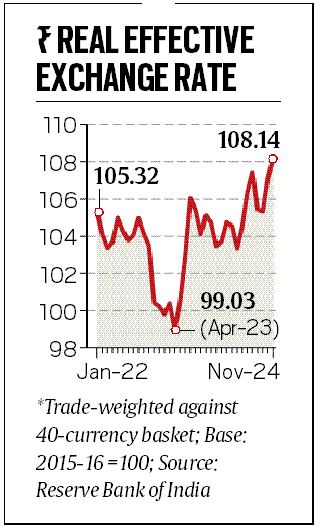The rupee is hitting fresh lows against the US dollar each day, yet its exchange rate has scaled an all-time-high in “real effective” terms.
The real effective exchange rate (REER) index of the rupee touched a record 108.14 in November, strengthening by 4.5 per cent during this calendar year, according to the latest Reserve Bank of India (RBI) data.

The REER measures the rupee’s value vis-à-vis not only the dollar, but other global currencies as well. In this case, it is a weighted average of the rupee’s exchange rate against a basket of 40 currencies of countries that account for about 88 per cent of India’s annual exports and imports. The REER also adjusts for inflation differentials between India and each of these trading partners.
Story continues below this ad
The rupee’s REER — an index similar to that for consumer prices or industrial production, with 2015-16 as the base year and currency weights derived from the shares of the individual countries in India’s total foreign trade — fell from 105.32 in January 2022 to 99.03 in April 2023. But since then, it has been on an appreciating trajectory, climbing to 107.20 in October and 108.14 in November this year (see chart).

The main reason for the divergence — the rupee’s simultaneous weakening and strengthening — has to do with the dollar’s behaviour over the past three months, especially post Donald Trump’s victory in the US presidential elections on November 5.
Between September 27 and December 24, the dollar index futures — a gauge of the greenback’s value relative to a basket of six currencies (euro, Japanese yen, British pound, Canadian dollar, Swedish krona and Swiss franc), with March 1973 as base — has gone up from 99.88 to 108.02. Much of that has been after November 5, when the index stood at 102.98.
Between September 27 and December 24, the rupee has depreciated from 83.67 to 85.19 against the dollar. During the same period, however, it has appreciated from 93.46 to 88.56 versus the euro, 112.05 to 106.79 versus the UK pound and 0.5823 to 0.5425 versus the Japanese yen.
Story continues below this ad
ExplainedWhy this hurts exports
rupee value above 100 as per REER signifies overvaluation and exchange rate not falling enough to offset higher domestic inflation. To that extent, it is overvalued, making imports cheaper but exports less cost competitive.
In other words, the rupee isn’t weakening as much as the dollar is strengthening — against all currencies. The dollar is strengthening because of Trump’s public pronouncements favouring universal tariff hikes (more so, on imports of Chinese goods), deficit-financed income tax cuts and mass deportations of illegal immigrants. These, if translated into policy actions, are expected to drive up inflation in the US and, in turn, force the US Federal Reserve to keep monetary policy tight. As 10-year government bond yields there have soared, from 3.75 per cent to 4.59 per cent between September 27 and December 24, it has led to capital flowing out of all countries, India included, to the US.
From a longer timeframe, the rupee has, since the start of 2022, dipped against the dollar (from 74.30 to 85.19), euro (84.04 to 88.56) and pound (100.30 to 106.79), while firming up only against the yen (0.6454 to 0.5425). Despite that, its REER has increased. And that is a result of inflation in India being higher relative to its major partners.
Assuming the rupee was “fairly” valued in 2015-16, when the REER was set to 100, any value above 100 signifies overvaluation and the exchange rate not falling enough to offset higher domestic inflation. The rupee is, to that extent, highly overvalued today, making imports into India cheaper and exports from the country less cost competitive. It probably also explains why the RBI is now allowing the rupee to fall — at least against the dollar.


































